Why the Need Variable Orifice Air Valve Technology? – A Brief Overview
The need for a Variable Orifice Air Valve specifically in preventing damaging Surge and Waterhammer has been understood for more than 40 years.
There have been several attempts to commercially produce a Variable Orifice Air Valve design. Most attempts required manual adjustment of the outlet orifice. Some designs never passed the development phase as they proved impractical in actual performance.
The patented AirFlo Variable Orifice is the only successful design that can automatically adjust the orifice diameter in accordance with the flow within the pipeline to ensure optimum Surge protection at all times.
Why the Need for a Variable Orifice Air Valve?
In the development of Anti-Shock or Anti-Slam Air valves, there are three observations that the developer will notice which limits the performance of The Anti-Shock design under rapid discharge conditions. These are:
- The limitation of the Anti-Shock orifice diameter – If the orifice is too small then, the valve may dampen the rapid Transient (Waterhammer) upon closure but will create Mass Oscillation (Surge). This is specifically damaging for GRP, PVC and HDPE Pipes.
- If the Orifice is too large – then the valve can still create a significant Transient on closure. This can convincingly be demonstrated with Surge Software.
- If the Valve does not “switch” to the Ant-Shock mode – as a result of oversizing, or the theoretical “switching” point not matching the Valve’s actual performance or, as a result of positioning too many valves on a pipeline. Under these conditions, the Valve will behave like a Kinetic Air Valve and create Air Valve Slam upon closure which will be damaging to the pipeline.
With a Variable Orifice Air Valve design all the above scenarios fall away as the Variable Orifice Valve will automatically adjust to the most ideal orifice size to provide optimum pipeline protection.
Some Designs Prior to the Development of Variable Orifice Technology
- Original Anti-Shock patent – the original concept behind the Anti-Shock Air Valve design was to have a multi float system, each with a different orifice size that progressively reduced. The intention was for the floats to progressively “switch” to a smaller outlet as the differential pressure across the valve increased. It was hoped that the valve would have switched to the smallest outlet prior to closure as it is the size of the orifice upon closure that would determine the magnitude and the amplitude of the surge. This design though patented was never commercially produced as it was impractical. It is for this reason that the Anti-Shock design is today commercially manufactured with one static orifice that cannot be varied thereby limiting its range of Surge and Waterhammer protection.
- Modifications to the Original Anti-Shock design – Some manufacturers, noting the disadvantage of a single static orifice developed an anti-shock float with multiple ports and would manually plug some of the ports to vary the overall outlet area. The disadvantage with this solution, is that if the valve is positioned in the wrong location during installation, then, the overall protection of the pipeline can be severely impacted. There are various other similar modifications with different Air Valve designs where there is an attempt to vary the outlet orifice as there is an acknowledgement for the need of a Variable Orifice design.
- Air Valve with a Throttling Device – these are Air Valves utilised mostly in the American market and normally installed on deep well pump applications where the throttling device is in the form of a disc that sits in a tapered Tee arrangement and the outlet orifice is manually adjusted by the adjustment of the disc in the tapered housing. The design is spring loaded to allow full air inflow vacuum conditions. There is a similar, but much older design principle utilised in the UK market and often called a Vented Non-Return Air Valve where this discharge rate can be varied by an adjusting a plug that sits in the discharge orifice. Experience specifically with the Vented Non-Return Air Valve, that pipeline filling is delayed substantially, and that the device induces Mass Oscillation (Surge) that can be extremely damaging to PVC, HDPE and GRP pipelines.
- Utilising the Pipeline or The Air Valve Riser to vary the discharge of multiple Air Valves on a single location – DS Clarke in a seminal technical paper titled “Surge Suppression a Warning” published in 19985, outlined the use of multiple air valve discharging different rates at the peak point of a pipeline. He utilised this principle on large pipelines in Saudi Arabia where the Air Valves were arranged on the pipeline and on a riser pipe in such a manner as to allow a predetermined amount of air to be release by air valves on the pipeline and the remaining air to be released through air valves situated on the accumulator. Several other similar concepts were developed specifically in France and utilised to assist in surge suppression. This concept has been revived in the South African market where several Air Valves are staggered on the accumulator of a large pipeline with the idea of each Air Valve sequentially closing as the water filling the accumulator thus varying the size of the discharge ports of the assembly to achieve a lower surge reduction. This principle imitates the Variable Orifice concept. It is emphasizing exactly what the Variable Orifice Design is achieving automatically namely that the magnitude and amplitude of any surge pressure is determined by the size of the discharge orifice prior to closure. The smaller the size of the discharge orifice in relation to the valve and main pipeline the lower the surge pressure.
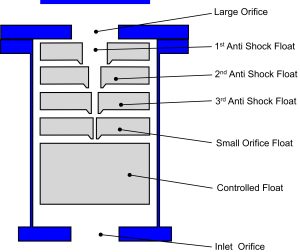
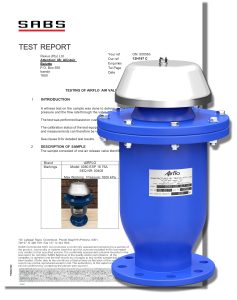
Figure 1 – On the left, the Original Anti-Shock Patent indicating the idea of progressively reducing the outlet orifice with a series of floats each progressively “switching” to a smaller orifice as the differential pressure across the large orifice. This design was not commercially viable hence the use of one Anti-Shock orifice float with a static orifice limiting the control of the valve’s surge protection. On the right, the AirFlo Variable Orifice achieves the varying of the outlet orifice automatically and in a compact design as tested by a 3rd party test authority across the valve’s entire range. In addition, the performance of the AirFlo Variable Orifice Air Valve design was comparatively tested against several other Air Valve designs.
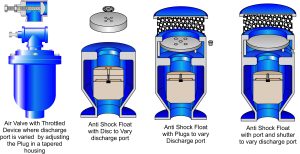
Figure 2 – Indicates four different Air Valve designs three of them modifications of the Anti-Shock designs where the manufacturers manually vary the discharge port of the air valve. The Air Valve on the left is commonly used in Deepwell applications where a plug is situated in a tapered housing and used to adjust the rate of air discharge. The AirFlo Variable Orifice Designs achieves the varying of the discharge orifice automatically.
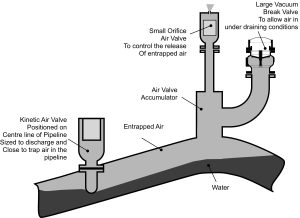
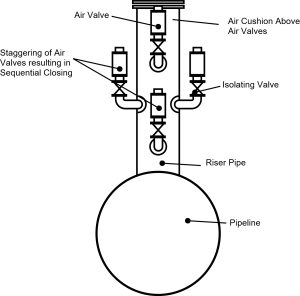
Figure 3 – On the left is the concept utilised on large diameter pipelines in Saudi Arabia in the 1980’s in essence utilising several air valves placed on the pipeline or on an accumulator to vary the discharge capacity as the valves released air with the aim of limiting surge but effectively de-aerating the pipeline. On the right is a concept for large diameter pipelines utilised in South Africa where the Air Valves are staggered on an accumulator allowing the varying of the air discharge. These two designs and several others indicate the understanding of the need for Variable Orifice Air Valve Technology.
Variable Orifice Air Valves – Intuitive Surge and Waterhammer Protection and Improved Vacuum Protection
The AirFlo Variable Orifice design infinitely and automatically adjusts to the flow velocity to prevent Waterhammer and minimise Surge. Response time is instantaneous and in exact tune with the pipeline operating condition ensuring optimum Surge and Waterhammer protections regardless of the flow velocity within the pipeline.
In addition, The AirFlo Variable Orifice Air Valve has been purposefully and aerodynamically designed to provide optimum Vacuum protection. The Valve’s internal configuration and Variable Orifice configuration assists in the Valve’s intake capacity providing between 23% and 35% higher intake for the same nominal size air valve under equal flow conditions in comparison to many other designs.
AirFlo Variable Orifice Air Valves amongst the many benefits, provides the two of most critical aspects of Air Valve design that of reliable and superior Surge protection and effective vacuum protection. This is why your pipeline requires AirFlo Variable Orifice Air Valve Technology!
Allistair Balutto (c)

